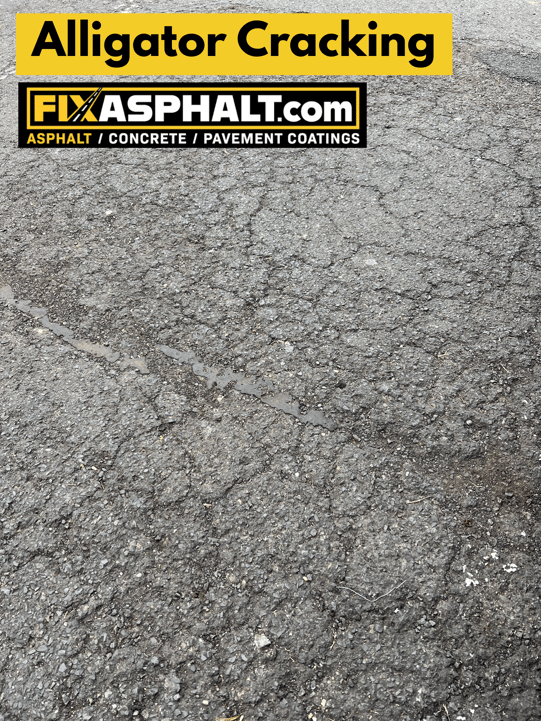Asphalt Maintenance Tips - Alligator Cracking 101

As a commercial property owner, facility manager, or property manager, it is crucial to ensure that your parking lot is in good condition. One common issue that you may encounter is alligator cracking. These interconnected cracks resemble the scaly skin of an alligator, hence the name. If left untreated, alligator cracking can lead to more significant damage, including potholes and structural issues. In this article, we will discuss what alligator cracking is, its causes, and what you can do to address this problem.
Understanding Alligator Cracking
Alligator cracking refers to a series of interconnected cracks that resemble the skin of an alligator. These cracks typically occur in the top layer of asphalt and can vary in size and shape. If you notice alligator cracking in your parking lot, it is a sign that the pavement is deteriorating.
There are several factors that can contribute to the development of alligator cracking:
- Insufficient foundation: If the foundation underneath the asphalt is weak or improperly constructed, it can cause the pavement to crack and deteriorate.
- Heavy traffic: Commercial parking lots are subjected to constant vehicle traffic, especially in busy areas. The repeated stress from heavy vehicles can lead to the formation of alligator cracks.
- Age: Over time, the asphalt binder in the pavement becomes less flexible and more susceptible to cracking.
- Poor drainage: If water is allowed to penetrate the pavement and saturate the base, it can weaken the structure and contribute to the development of cracks.
Now that you understand the causes of alligator cracking, let's discuss some asphalt maintenance tips to help you address this issue.
Regular Parking Lot Inspections
One of the most important steps in maintaining your parking lot is conducting regular inspections. By visually assessing the condition of the pavement, you can identify any signs of distress, including alligator cracking. Inspections should be conducted at least twice a year, preferably in the spring and fall, as extreme weather conditions can accelerate pavement deterioration.
During the inspection, pay close attention to areas with heavy traffic, such as entrances, exits, and turning points. These areas are more prone to developing alligator cracking due to the constant stress they endure.
Crack Sealing Methods
When it comes to addressing alligator cracking, crack sealing is an effective method that can prevent further deterioration and extend the lifespan of your parking lot. Here are a few crack sealing methods to consider:
1. Hot Rubberized Crack Sealing
This method involves heating rubberized asphalt crack filler and applying it to the cracks using a specially designed applicator. The hot rubberized material fills the cracks, creating a waterproof seal that prevents moisture from penetrating the pavement. Hot rubberized crack sealing is an excellent option for alligator cracking as it provides long-lasting protection.
2. Routing and Sealing
If the cracks in your parking lot are severe, routing and sealing may be necessary. This method involves cutting a reservoir along the crack using a specialized machine and then filling it with a rubberized sealant. Routing helps to remove any deteriorated pavement and allows the sealant to adhere better, prolonging the life of the repair.
3. Asphalt Overlay
In cases where alligator cracking is extensive and the pavement is severely damaged, an asphalt overlay may be the best solution. An asphalt overlay involves placing a new layer of asphalt over the existing pavement. This not only covers up the cracks but also provides a smooth and durable surface. However, an overlay should only be considered if the base of the parking lot is still in good condition.
Preventive Measures For Parking Lot Maintenance
While crack sealing methods can help address alligator cracking, it is also important to implement preventive measures to avoid future issues. Here are some preventive measures you can take:
- Proper drainage: Ensure that your parking lot has proper drainage to prevent water from pooling on the surface. Standing water can weaken the pavement and accelerate deterioration.
- Regular maintenance: Schedule regular maintenance tasks such as sealcoating and crack sealing to protect and extend the life of your asphalt pavement.
- Restrict heavy vehicles: If possible, try to limit the amount of heavy vehicle traffic in your parking lot. Heavy vehicles can cause significant stress on the pavement, leading to alligator cracking and other forms of damage.
- Address cracks promptly: When you notice any cracks forming, repair them promptly to prevent them from spreading and becoming more severe.
By implementing these preventive measures and conducting regular inspections, you can minimize the occurrence of alligator cracking and ensure the longevity of your parking lot.
Conclusion
Alligator cracking is a common issue that commercial property owners, facility managers, and property managers face. By understanding the causes of alligator cracking and implementing proper maintenance strategies, you can address this issue effectively. Regular inspections, crack sealing methods, and preventive measures are all vital components of maintaining a durable and safe parking lot. Remember, addressing alligator cracking promptly can save you time and money in the long run.











Leave a Comment